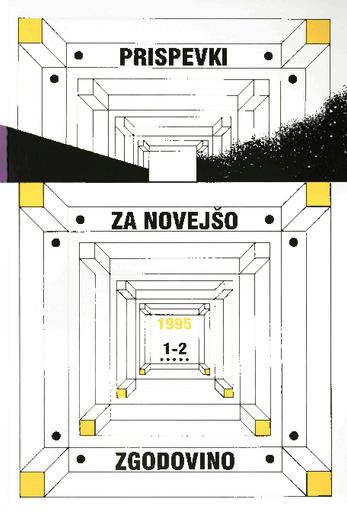/
Periodicals
/
Prispevki za novejšo zgodovino
Slovene People's Party and the Introduction of Autonomous Districts in 1927


This work by Miroslav Stiplovšek is licensed under Creative Commons Attribution-NonCommercial-NoDerivs 4.0 International
Files (1)

Description
In the forefront of the Slovene political life at the turn of 1926 and 1927 was the issue of self-government, which was being introduced in the largest, newly established administrative districts, in accordance with the provisions of Vidovdan Constitution, after more than a five year deferment caused by the centralists opposition. This issue also caused changes in the Government. The author highlights the position of the Slovene People's Party with regards to these autonomous districts which were due to their low competencies, far from the party's autonomist constitutional claims, and its attempt as a government party, to expand, as much as possible, the autonomy of Ljubljana and Maribor Districts and thus strengthen its political domination in Slovenia.
Metadata (12)
- identifierhttps://hdl.handle.net/11686/2092
- title
- Slovenska ljudska stranka in uvedba oblastnih samouprav leta 1927
- Slovene People's Party and the Introduction of Autonomous Districts in 1927
- creator
- Miroslav Stiplovšek
- contributor
- Jasna Fischer (odg. ur.)
- subject
- Kraljevina SHS
- oblasti
- samouprava
- SLS
- description
- In the forefront of the Slovene political life at the turn of 1926 and 1927 was the issue of self-government, which was being introduced in the largest, newly established administrative districts, in accordance with the provisions of Vidovdan Constitution, after more than a five year deferment caused by the centralists opposition. This issue also caused changes in the Government. The author highlights the position of the Slovene People's Party with regards to these autonomous districts which were due to their low competencies, far from the party's autonomist constitutional claims, and its attempt as a government party, to expand, as much as possible, the autonomy of Ljubljana and Maribor Districts and thus strengthen its political domination in Slovenia.
- Na prelomu let 1926/1927 so po več kot petletnem odlaganju zaradi odpora centralistov uvedli samoupravo v največjih administrativnih enotah - oblasteh. Uveljavitev samouprave v skladu z določili vidovdanske ustave je bila takrat v ospredju političnega življenja v državi in je pomembno vplivala tudi na spremembe vlade. Avtor je osvetlil poglede Slovenske ljudske stranke na oblastne samouprave, ki so bile zaradi skromnih pristojnosti daleč od njenih avtonomističnih ustavnopravnih zahtev, in njeno odločitev, da bo kot vladna stranka poskušala čimbolj razširiti samoupravo ljubljanske in mariborske oblasti ter utrditi svojo dominacijo na Slovenskem.
- publisher
- Inštitut za novejšo zgodovino
- date
- 1995
- type
- besedilo
- language
- Slovenščina
- isPartOf
- rights
- license: ccByNcNd
Citirano v (1)
| Tipologija | Avtor(ji) | Naslov | Kraj | Založba | Leto |
|---|---|---|---|---|---|
| 1.01 Izvirni znanstveni članek | Steinbacher, Nina | Začetki političnega agrarnega gibanja na Slovenskem : prispevek k predzgodovini ustanovitve Samostojne kmetijske stranke | Ljubljana | Inštitut za novejšo zgodovino | 2020 |
Seznam literature v delu (2)
| Stran | Avtor | Naslov | Vir | Kraj | Založba | Leto |
|---|---|---|---|---|---|---|
| 35 | Perovšek, Jurij | Unitaristični in centralistični značaj vidovdanske ustave | Prispevki za novejšo zgodovino | Ljubljana | Inštitut za novejšo zgodovino | 1993 |
| 36 | Perovšek, Jurij | Slovenski liberalni tabor in nacionalno vprašanje v času Kraljevine Srbov, Hrvatov in Slovencev : (doktorska disertacija) | Ljubljana | [J. Perovšek] | 1993 |
